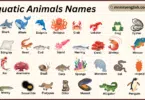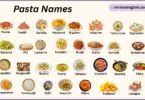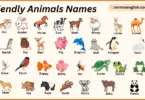Learning the names of different rocks can increase the part of your knowledge about nature. Rocks are found everywhere on Earth and are an important part of nature. Some common rocks names are, Shale, slate, marble, quartzite, gneiss, schist, dolomite, conglomerate, breccia, and rhyolite. In this article, I have covered Types of Rocks Names in English and Their Pictures which can help you talk about Rocks in English. Pictures are helpful to remember their shapes and names. All are given below, let’s learn…
Types of Rocks Names in English
- Granite
- Basalt
- Limestone
- Sandstone
- Shale
- Slate
- Marble
- Quartzite
- Gneiss
- Schist
- Dolomite
- Conglomerate
- Breccia
- Rhyolite
- Andesite
- Obsidian
- Pumice
- Tuff
- Travertine
- Diorite
Rocks Names and Pictures in English
- Granite:
A hard, durable igneous rock often used for buildings and countertops.

- Basalt:
A dark, fine-grained volcanic rock commonly found in oceanic crust.

- Limestone:
A sedimentary rock made mostly of calcium carbonate, often used in construction.

- Sandstone:
A sedimentary rock made from compacted sand grains, often seen in layered formations.

- Shale:
A soft sedimentary rock formed from compressed clay, commonly used for pottery.

- Slate:
A fine-grained metamorphic rock that splits into thin layers, often used for roofing.

- Marble:
A metamorphic rock known for its smooth texture and used in sculptures and flooring.

- Quartzite:
A hard metamorphic rock formed from quartz sandstone, used in decorative stones.

- Gneiss:
A banded metamorphic rock formed under high pressure and temperature.

- Schist:
A shiny metamorphic rock with layers, often rich in mica minerals.

- Dolomite:
A sedimentary rock similar to limestone but containing magnesium, used in cement.

- Conglomerate:
A sedimentary rock made of rounded pebbles cemented together.

- Breccia:
A sedimentary rock composed of sharp, angular fragments bound by minerals.

- Rhyolite:
A light-colored volcanic rock, often found in explosive volcanic eruptions.

- Andesite:
A gray volcanic rock common in volcanic mountain regions.

- Obsidian:
A shiny, black volcanic glass formed from rapidly cooling lava.

- Pumice:
A lightweight volcanic rock full of air bubbles, often used for scrubbing.

- Tuff:
A soft volcanic rock formed from compacted ash, often used as a building material.

- Travertine:
A type of limestone deposited by mineral springs, commonly used in tiles.

- Diorite:
A coarse-grained igneous rock, often used for statues and monuments.

List of Rocks in English
- Peridotite
- Gabbro
- Chert
- Flint
- Jasper
- Onyx
- Serpentinite
- Arkose
- Siltstone
- Coal
- Phyllite
- Lignite
- Anthracite
- Chalk
- Gypsum
- Anhydrite
- Hornfels
- Eclogite
- Scoria
- Pegmatite
Different types of rocks Images with names
- Peridotite:
A dense, dark igneous rock rich in olivine, often found in the Earth’s mantle.

- Gabbro:
A coarse-grained igneous rock similar to basalt, commonly used in construction.

- Chert:
A hard sedimentary rock made of quartz, often used for tools in ancient times.

- Flint:
A type of chert with a smooth texture, used for making fire and tools.

- Jasper:
A colorful, opaque variety of quartz often used in jewelry and decoration.

- Onyx:
A layered, banded form of quartz used in carvings and ornaments.

- Serpentinite:
A green, metamorphic rock with a slippery texture, formed from ultramafic rocks.

- Arkose:
A type of sandstone rich in feldspar, usually pink or red in color.

- Siltstone:
A fine-grained sedimentary rock made of compacted silt particles.

- Coal:
A black sedimentary rock formed from ancient plant matter, used as fuel.

- Phyllite:
A shiny, fine-grained metamorphic rock with a wavy texture, used in construction.

- Lignite:
A soft, brown type of coal with lower energy content, used for electricity.

- Anthracite:
The hardest and cleanest-burning type of coal, rich in carbon.

- Chalk:
A soft, white sedimentary rock made of microscopic sea organism remains.

- Gypsum:
A soft, white rock used to make plaster and drywall.

- Anhydrite:
A mineral similar to gypsum but without water, used in cement and fertilizers.

- Hornfels:
A hard, dense metamorphic rock formed by heat without pressure.

- Eclogite:
A rare, high-pressure metamorphic rock with green and red minerals.

- Scoria:
A dark, porous volcanic rock that is lightweight and often used in landscaping.

- Pegmatite:
An igneous rock with very large crystals, often containing rare minerals.

60 Rocks Names in English
- Syenite
- Carbonatite
- Kimberlite
- Soapstone
- Lapis Lazuli
- Dolostone
- Ironstone
- Bauxite
- Greensand
- Laterite
- Siderite
- Bornite
- Magnesite
- Malachite
- Chrysocolla
- Epidote
- Diatomite
- Argillite
- Bentonite
- Catlinite
Rocks Pictures and names in English
- Syenite:
A coarse-grained igneous rock similar to granite but without quartz, used in construction.

- Carbonatite:
A rare igneous rock made mostly of carbonate minerals, often linked to rare-earth deposits.

- Kimberlite:
An igneous rock famous for containing diamonds, found deep in volcanic pipes.

- Soapstone:
A soft, heat-resistant metamorphic rock used for carvings and countertops.

- Lapis Lazuli:
A deep blue metamorphic rock prized for jewelry and decorative uses.

- Dolostone:
A sedimentary rock made primarily of the mineral dolomite, used in building and industry.

- Ironstone:
A sedimentary rock rich in iron, often used as an ore for steel production.

- Bauxite:
A sedimentary rock that is the main source of aluminum.

- Greensand:
A green, sandy rock rich in glauconite, often used as a soil conditioner.

- Laterite:
A reddish rock formed in tropical regions, rich in iron and aluminum oxides.

- Siderite:
An iron carbonate mineral that is sometimes used as an iron ore.

- Bornite:
A copper-rich mineral with a metallic shine, often called “peacock ore” for its colors.

- Magnesite:
A carbonate mineral used to make refractory materials and magnesium products.

- Malachite:
A bright green copper carbonate rock often used in jewelry and ornaments.

- Chrysocolla:
A blue-green copper mineral used in decorative stones and jewelry.

- Epidote:
A green metamorphic mineral often found in altered igneous rocks.

- Diatomite:
A soft, light sedimentary rock made of fossilized algae, used in filtration and insulation.

- Argillite:
A fine-grained sedimentary rock formed from hardened clay, often used for carvings.

- Bentonite:
A clay-rich rock that swells when wet, used in drilling and as a sealant.

- Catlinite:
A soft, reddish rock also known as pipestone, used by Native Americans for carvings.

More Helpful Articles







































































Leave a Comment